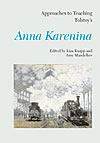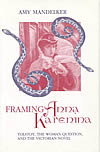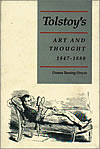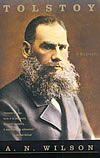Books About Anna Karenina

Want to take the next step in your understanding of
Tolstoy's lively, complicated novel? Many literary experts have taken a crack at
explaining the nuances of this book—and we've collected some of the best
resources right here!
Approaches to Teaching Tolstoy's Anna KareninaEdited by Liza Knapp and Amy Mandelker
Tolstoy's Anna Karenina is probably the most often taught 19th- century Russian novel in the American academy. Teachers have found that including this virtuoso work of art on a syllabus reaps many rewards, especially in courses that connect texts thematically (e.g., Adultery in the Novel) or theoretically (e.g., Russian Literature into Film, Theory of Narrative). It also stirs up heated classroom discussion—on sex and sexuality, dysfunction in the family, gender roles, society's hypocrisy and cruelty. But because of translation and transliteration problems, the peculiarity of Russian names and terms, the unfamiliarity of Russian geography and history, and the very size of the novel, teaching it presents challenges. This volume provides a comprehensive resource for dealing with these difficulties.
Learn more about the book from the Modern Library Association.

Framing Anna Karenina
By Amy Mandelker
Amy Mandelker's feminist reinterpretation of Tolstoy's Anna Karenina challenges prevailing critical notions of Tolstoy as a misogynist and Anna Karenina as a classic realist novel. Instead, Mandelker reads Tolstoy as a radical feminist at the vanguard of Russia's "woman question" debates and Anna Karenina as a modernist novel that breaks tradition.
Mandelker's revisionist analysis begins with the contention that Anna Karenina rejects the textual conventions of realism and the stereotypical representation of women, especially in Victorian English fiction. In Anna Karenina, Tolstoy uses the theme of art and visual representation to articulate aesthetics freed from gender bias and class discrimination. As Mandelker shows, Tolstoy compares the theme of the representation of women in society with the representation of women in art to critique Western bourgeois traditions that trivialize the beautiful as a feminine category in aesthetics and a purchasable commodity in society. In Anna Karenina, Tolstoy both creates and theorizes an aesthetics that transcends boundaries and liberates the individual.
An important and compelling work, Framing Anna Karenina is essential reading for scholars and students of Russian and Victorian literature, particularly those interested in feminist approaches to 19th-century novels.
Learn more about the book from Ohio State University Press.
By Amy Mandelker
Amy Mandelker's feminist reinterpretation of Tolstoy's Anna Karenina challenges prevailing critical notions of Tolstoy as a misogynist and Anna Karenina as a classic realist novel. Instead, Mandelker reads Tolstoy as a radical feminist at the vanguard of Russia's "woman question" debates and Anna Karenina as a modernist novel that breaks tradition.
Mandelker's revisionist analysis begins with the contention that Anna Karenina rejects the textual conventions of realism and the stereotypical representation of women, especially in Victorian English fiction. In Anna Karenina, Tolstoy uses the theme of art and visual representation to articulate aesthetics freed from gender bias and class discrimination. As Mandelker shows, Tolstoy compares the theme of the representation of women in society with the representation of women in art to critique Western bourgeois traditions that trivialize the beautiful as a feminine category in aesthetics and a purchasable commodity in society. In Anna Karenina, Tolstoy both creates and theorizes an aesthetics that transcends boundaries and liberates the individual.
An important and compelling work, Framing Anna Karenina is essential reading for scholars and students of Russian and Victorian literature, particularly those interested in feminist approaches to 19th-century novels.
Learn more about the book from Ohio State University Press.
The Unsaid Anna Karenina
By Judith Armstrong
Providing insight into the hidden psychology of Anna Karenina and the motivations of its author, Australian Russian literature specialist Judith Armstrong reflects upon the subtext of Tolstoy's complicated work. Why does Anna do what she does? What is Tolstoy's true relationship to his heroine? How do the other characters reveal themselves in unique and fascinating ways? Armstrong explores it all.
By Judith Armstrong
Providing insight into the hidden psychology of Anna Karenina and the motivations of its author, Australian Russian literature specialist Judith Armstrong reflects upon the subtext of Tolstoy's complicated work. Why does Anna do what she does? What is Tolstoy's true relationship to his heroine? How do the other characters reveal themselves in unique and fascinating ways? Armstrong explores it all.
Cambridge Companion to Tolstoy
Edited by Donna Tussing Orwin
Best known for his great novels, War and Peace and Anna Karenina, Tolstoy remains one the most important 19th-century writers; throughout his career, which spanned nearly three quarters of a century, he wrote fiction, journalistic essays and educational textbooks. The specially commissioned essays in The Cambridge Companion to Tolstoy do justice to the sheer volume of Tolstoy's writing. Key dimensions of his writing and life are explored in essays focusing on his relationship to popular writing, the issue of gender and sexuality in his fiction, and his aesthetics. The introduction provides a brief, unified account of the man, for whom his art was but one activity among many. The volume is well supported by supplementary material, including a detailed guide to further reading and a chronology of Tolstoy's life, the most comprehensive compiled in English to date. Altogether, the volume provides an invaluable resource for students and scholars alike.
Learn more about the book from Cambridge University Press.
Edited by Donna Tussing Orwin
Best known for his great novels, War and Peace and Anna Karenina, Tolstoy remains one the most important 19th-century writers; throughout his career, which spanned nearly three quarters of a century, he wrote fiction, journalistic essays and educational textbooks. The specially commissioned essays in The Cambridge Companion to Tolstoy do justice to the sheer volume of Tolstoy's writing. Key dimensions of his writing and life are explored in essays focusing on his relationship to popular writing, the issue of gender and sexuality in his fiction, and his aesthetics. The introduction provides a brief, unified account of the man, for whom his art was but one activity among many. The volume is well supported by supplementary material, including a detailed guide to further reading and a chronology of Tolstoy's life, the most comprehensive compiled in English to date. Altogether, the volume provides an invaluable resource for students and scholars alike.
Learn more about the book from Cambridge University Press.

Tolstoy's Art and Thought, 1847-1880
By Donna T. Orwin
"My aim is to present Tolstoy's work as he may have understood it himself," writes Donna Orwin. Reconstructing the intellectual and psychic struggles behind the masterpieces of his early and middle age, this major study covers the period during which he wrote The Cossacks, War and Peace, and Anna Karenina. Orwin uses the tools of biography, intellectual and literary history, and textual analysis to explain how Tolstoy's tormented search for moral certainty unfolded, creating fundamental differences among the great novels of the "pre-crisis" period. Distinguished by its historical emphasis, this book demonstrates that the great novelist, who had once seen a fundamental harmony between human conscience and nature's vitality, began eventually to believe in a dangerous rift between the two: during the years discussed here, Tolstoy moved gradually from a celebration of life to instruction about its moral dimensions. Paying special attention to Tolstoy's reading of Rousseau, Goethe, Schopenhauer, and the Russian thinker N. N. Strakhov, Orwin also explores numerous other influences on his thought. In so doing, she shows how his philosophical and emotional conflicts changed form but continued unabated—until, with his religious conversion of 1880, he surrendered his long attempt to make sense of life through art alone.
By Donna T. Orwin
"My aim is to present Tolstoy's work as he may have understood it himself," writes Donna Orwin. Reconstructing the intellectual and psychic struggles behind the masterpieces of his early and middle age, this major study covers the period during which he wrote The Cossacks, War and Peace, and Anna Karenina. Orwin uses the tools of biography, intellectual and literary history, and textual analysis to explain how Tolstoy's tormented search for moral certainty unfolded, creating fundamental differences among the great novels of the "pre-crisis" period. Distinguished by its historical emphasis, this book demonstrates that the great novelist, who had once seen a fundamental harmony between human conscience and nature's vitality, began eventually to believe in a dangerous rift between the two: during the years discussed here, Tolstoy moved gradually from a celebration of life to instruction about its moral dimensions. Paying special attention to Tolstoy's reading of Rousseau, Goethe, Schopenhauer, and the Russian thinker N. N. Strakhov, Orwin also explores numerous other influences on his thought. In so doing, she shows how his philosophical and emotional conflicts changed form but continued unabated—until, with his religious conversion of 1880, he surrendered his long attempt to make sense of life through art alone.
Leo Tolstoy: Resident and Stranger
By Richard F. Gustafson
This serious and important book challenges the widely held view of Tolstoy as two radically different men, "the pre-conversion artist and the post-conversion religious thinker." By using the later works to clarify the earlier ones, Gustafson argues persuasively for the essential coherence of Tolstoy's work, a coherence that stems from his religious thinking and his desperate life-long search for faith. This book is a remarkable piece of scholarship and should appeal both to scholars and the general public, especially those interested in Tolstoy's work, in theology, or in the history of ideas.
By Richard F. Gustafson
This serious and important book challenges the widely held view of Tolstoy as two radically different men, "the pre-conversion artist and the post-conversion religious thinker." By using the later works to clarify the earlier ones, Gustafson argues persuasively for the essential coherence of Tolstoy's work, a coherence that stems from his religious thinking and his desperate life-long search for faith. This book is a remarkable piece of scholarship and should appeal both to scholars and the general public, especially those interested in Tolstoy's work, in theology, or in the history of ideas.
Tolstoy or Dostoevsky
By George Steiner
George Steiner's Tolstoy or Dostoevsky has become a classic among scholars of Russian literature. An essay in poetic and philosophic criticism that bears mainly on the Russian masters, Tolstoy or Dostoevsky deals also with larger themes: the epic tradition extending from Homer to Tolstoy; the continuity of a "tragic world view" from Oedipus Rex to King Lear and The Brothers Karamazov; the contrasts between the epic and dramatic modes, between irreconcilably opposed views of God and of history. Moreover, in this work Steiner shows a great depth and breadth of literary knowledge and criticism that is not limited alone to the Russian writers under discussion, but to writers of all genres and all literary periods. Steiner's book is a must for the student, scholar or general reader who wishes to approach the Russian giants in their full literary and philosophical ambience.
Learn more about the book from Yale University Press.
By George Steiner
George Steiner's Tolstoy or Dostoevsky has become a classic among scholars of Russian literature. An essay in poetic and philosophic criticism that bears mainly on the Russian masters, Tolstoy or Dostoevsky deals also with larger themes: the epic tradition extending from Homer to Tolstoy; the continuity of a "tragic world view" from Oedipus Rex to King Lear and The Brothers Karamazov; the contrasts between the epic and dramatic modes, between irreconcilably opposed views of God and of history. Moreover, in this work Steiner shows a great depth and breadth of literary knowledge and criticism that is not limited alone to the Russian writers under discussion, but to writers of all genres and all literary periods. Steiner's book is a must for the student, scholar or general reader who wishes to approach the Russian giants in their full literary and philosophical ambience.
Learn more about the book from Yale University Press.

Tolstoy: A Biography
By A. N. Wilson
In this landmark biography of Count Lev Nikolayevich Tolstoy, A.N. Wilson narrates the complex drama of the writer's life: his childhood of aristocratic privilege and emotional deprivation, his discovery of his literary genius after aimless years of gambling and womanizing, and his increasingly disastrous marriage. Wilson sweeps away the long-held belief that Tolstoy's works were the exact mirror of his life, and instead traces the roots of Tolstoy's art to his relationship with God, with women and with Russia. He also breaks new ground in recreating the world that shaped the great novelist's life and art—the turmoil of ideas and politics in 19th-century Russia and the incredible literary renaissance that made Tolstoy's work possible.
Looking to learn more about the other works by Tolstoy? Find a bookshelf full of them here!
By A. N. Wilson
In this landmark biography of Count Lev Nikolayevich Tolstoy, A.N. Wilson narrates the complex drama of the writer's life: his childhood of aristocratic privilege and emotional deprivation, his discovery of his literary genius after aimless years of gambling and womanizing, and his increasingly disastrous marriage. Wilson sweeps away the long-held belief that Tolstoy's works were the exact mirror of his life, and instead traces the roots of Tolstoy's art to his relationship with God, with women and with Russia. He also breaks new ground in recreating the world that shaped the great novelist's life and art—the turmoil of ideas and politics in 19th-century Russia and the incredible literary renaissance that made Tolstoy's work possible.
Looking to learn more about the other works by Tolstoy? Find a bookshelf full of them here!



